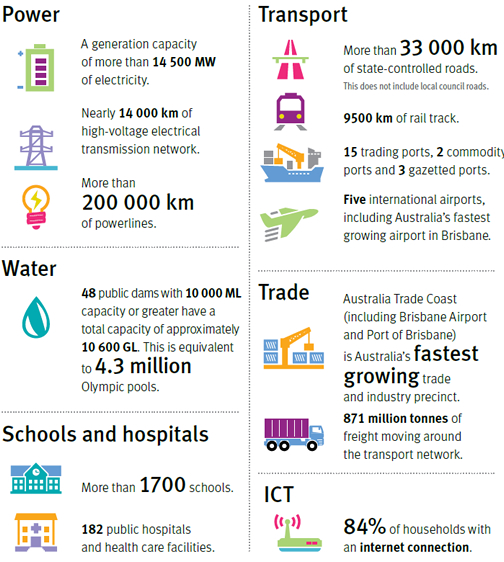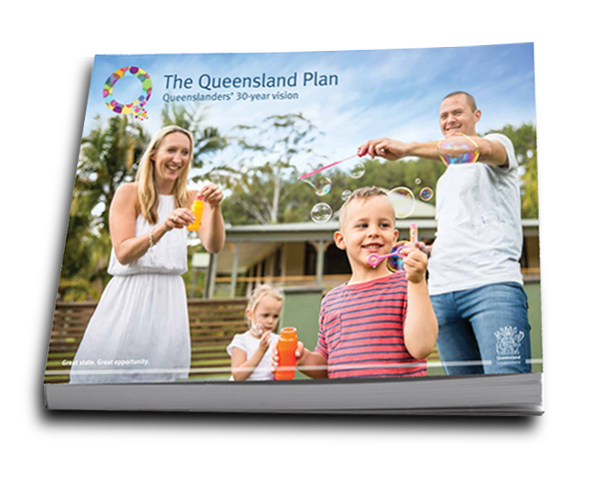Infrastructure
On this page:
- Queenslanders’ vision for our infrastructure
- Why infrastructure is a foundation
- Spotlight on our infrastructure
- What Queenslanders want
- Achieving success
- Get involved
Queenslanders’ vision for our infrastructure
In 2044, all Queenslanders will have access to the services they need, through our sophisticated and world-class infrastructure. Our infrastructure will drive economic growth and will be a key enabler in the digital economy. From our homes, and from our businesses and workplaces, we will be connected to the world. The goods we order will be delivered when we need them and the services we use will be reliable, efficient and meet our needs. Our exports will enter the global market seamlessly, ensuring we remain competitive in the international marketplace.
Why infrastructure is a foundation
Our access to clean water, reliable energy supplies, communication technology and public infrastructure provides an enviable standard of living. Read more on page 75 of The Queensland Plan.
Spotlight on our infrastructure

What Queenslanders want
The following goals highlight what Queenslanders said they wanted to be, do or achieve (in relation to this foundation). These goals are accompanied by the outcomes Queenslanders said they want to see. Read detailed descriptions of success factors in The Queensland Plan.
| Goal | What does success look like? |
|---|---|
| G28 Our infrastructure fits our changing population and demographics. |
We take a long-term approach to planning and delivery through infrastructure, recognising that infrastructure supports population growth across the state.* |
| We deliver essential services effectively. | |
| We use existing infrastructure efficiently. | |
| G29 Our regions, businesses and communities reach their full potential. |
We have effective access to water, energy, transport and ICT to keep the economy moving. |
| We deliver economic, social and community benefits through infrastructure.* | |
| G30 Infrastructure is funded in a variety of ways. |
We use public funds more efficiently. |
| There is an increase in private investment. | |
| G31 Infrastructure is designed and built with longevity in mind. |
Our infrastructure is resilient and sustainable. |
| We use technology effectively. | |
| G32 Infrastructure provides connectivity and accessibility across the state. |
Our transport system is cost-effective and integrated. |
| Our communications network is integrated. |
*A top 10 priority identified by delegates at the Brisbane Summit.
Achieving success
The following targets and measures will help focus our efforts towards achieving success. The baselines have been sourced from existing data sets as a starting point for future reporting. Download The Queensland Plan for a detailed explanation of what the measures show.
T19 Tailored and timely
The right infrastructure is delivered in a timely way to support economic growth and social needs.
| Primary measure | Starting point or baseline | ||||
|---|---|---|---|---|---|
Community satisfactionPercentage of Queenslanders who are satisfied with infrastructure in Queensland in a state survey. Source: State survey.
|
Baseline to be created 2014–15 through a state survey. |
||||
Access to servicesPercentage of Queenslanders who experienced problems accessing services due to ‘inadequate services in an area where they reside’ or ‘no services in an area where they reside’. Source: ABS 4159.0.55.003 (2012), General Social Survey: States and Territories, 2010.
|
Baseline: Queenslanders experiencing problems accessing services in the area where they reside, 2010. |
| Secondary measure | Starting point or baseline | ||||
|---|---|---|---|---|---|
Access to public transportPercentage of the population that live within 400 metres of a public transport stops. Source: Department of Transport and Main Roads (2013).
|
Baseline: Queenslanders with proximity to public transport (within 400m of a Translink or qconnect network stop, geodesic distance only), 2013. |
||||
Access to health servicesPercentage of Queenslanders who have experienced problems accessing doctors or hospitals. Source: ABS 4159.0.55.003 (2012), General Social Survey: States and Territories, 2010.
|
Baseline: Queenslanders experiencing problems accessing doctors or hospitals, 2010. |
||||
Access to telecommunicationsProportion of Queenslanders who have experienced problems accessing telecommunications services. Source: ABS 4159.0.55.003 (2012), General Social Survey: States and Territories, 2010.
|
14.0% of Queenslanders have problems accessing telecommunications. Baseline: Queenslanders experiencing problems accessing telecommunications services, 2010. |
||||
Freight movementTotal volume of Queensland’s freight comprising of export, import and domestic freight movement. Source: Department of Transport and Main Roads (2013), Moving Freight: A Strategy for more efficient freight movement.
|
871 million tonnes of freight moved annually. Baseline: Queensland’s total freight volume comprising of export, import and domestic freight movement, 2010–11. |
Return to the foundations landing page to understand the purpose of the targets and measures or to select another foundation area to learn about.
Get involved
There are many ways you can help achieve our vision. Visit our Get involved page to read a few suggestions related to each foundation area.




